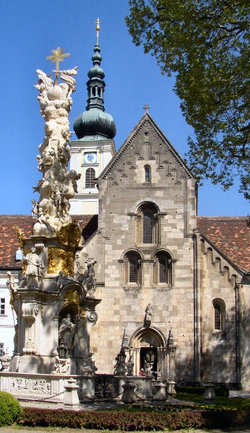Gregorian chant in Heiligenkreuz, Austria sells over 200,000 copies
Thursday, June 26, 2008

I love Gregorian chant, and today the New York Times has an article on the monks at Heiligenkreuz Abbey in Austria that have become a kind of celebrity after the popularity of their latest album. According to the article:
When the album, “Chant: Music for Paradise,” was released in Europe in May — and shot to No. 7 in the British pop charts, at one point outselling releases from Amy Winehouse and Madonna — the trickle of press attention turned into a torrent. (The CD will be released in the United States on Tuesday.)
Now this monastery, where the daily rituals of prayer and work have guided life for 875 years, finds itself in a media whirligig at once exhilarating and unsettling for its 77 brothers.
“We’re monks,” said Johannes Paul Chavanne, 25, a Viennese who entered the monastery after studying law and is training to be a priest. “We’re not pop stars, and we don’t want to be pop stars.”
Too late: the album has made the monks of Heiligenkreuz a crossover hit, the latest example of how Gregorian chant, a once-neglected 1,000-year-old part of the Roman Catholic liturgy, can be repackaged for a secular society that savors its soothing, otherworldly cadences.
I thought that it might have been the same monks that I remembered from the early 90s (but not the name of), but that's a different group:
In 1994, the Benedictines of Santo Domingo de Solis in Spain prompted the last big revival of Gregorian chant with an album that became a phenomenon. More recently, the use of chant on the popular video game Halo has piqued interest.
Eager to get in on the trend, Universal’s classical music label took out an advertisement in Catholic publications, inviting chant groups to submit their work. Finding another ensemble like the Benedictines was going to be a long shot, the label’s executives figured.
“Not all monks want to enter into a commercial relationship because that’s not what they spend their days doing,” said Tom Lewis, the artist development manager in London for Universal Classics & Jazz.
But the advertisement was spotted by the grandson of a monk from here. He tipped off Father Wallner, who, in addition to his public-relations duties, runs the monastery’s theological academy and its Web site.
“An Austrian monk would never know what Universal Music is,” Father Wallner said. “We were chosen by divine providence to show that it is possible to have a healthy religious life today.”
...While monks in many monasteries chant, Heiligenkreuz is particularly proud of its singing, which has been honed over years by one of the monks, who used to direct choirs in Germany.
Nice. The first time I remember hearing Gregorian chant was in 1990 (I was 10 or 11) and every night I would listen to a station called AM106 in Calgary that had a top ten list at 10 pm, which I would listen to before I went to bed. One of the songs on the list was Enigma's Sadness Part 1, which starts with Gregorian chant and continues with it throughout the song. Most people know the song quite well but here it is just in case:
So where will the money be used?
The monks will never tour or perform on stage. And Heiligenkreuz will earn a royalty based on the sales of the album, which the abbot said worked out to roughly 1 euro per CD sold.The monastery’s share, Father Henckel Donnersmark figures optimistically, could be between $1.5 million and $3.1 million, which it will use to help finance the theological studies of young men from developing countries.The only part I don't like is that they've made the music on the condition that it never gets used in video games or pop music. Pop music is where I first heard Gregorian chant and video games and their music can be just as beautiful:
But hey, I doubt your average monk is that well-versed in video games so it's no big deal.
Lastly, here's one of the videos they've uploaded to YouTube and an image of the abbey church from the outside:







0 comments:
Post a Comment